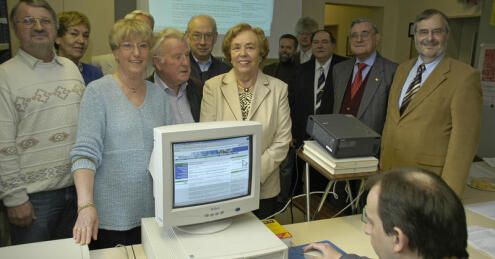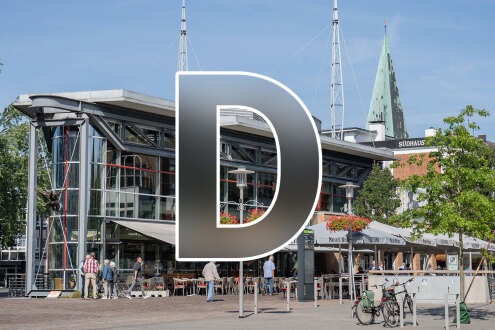D
D
Dalks Darp
This railway was founded in April 1910. The impetus for this was the lack of transport connections between Gelderland in the Netherlands and the Lower Rhine-Westphalian region on the Prussian side. The new railways only connected the metropolises. In the rural areas, everything still had to be transported by slow horse-drawn carts. Industry and agriculture in these regions were therefore at a great disadvantage.
The law of July 1892 then made it possible for municipal and private interests to open up structurally weak areas by means of a railway that could be built at low cost. The above-mentioned line was a small railway with the character of a tramway. It was hoped that it would be better able to cope with the heavy commuter traffic from Gelderland to Bocholt. The railway was operated by the Geldersch-Westfaalsche Stoomtram Maatschappij (GWSM), founded in 1905 and based in Lichtenvoorde. The railway had a track gauge of 750 mm. The construction cost was around 500,000 guilders. The terminus was located in Bocholt on the square on today's Meckenemstraße. There was a small station house and a goods shed. Four three-axle steam locomotives were available, as well as six passenger carriages and 12 goods wagons.
The tracks laid from Meckenemplatz to Bocholt railway station were never allowed to be used as originally intended. Operation of the tramway was discontinued during the First World War on 1 May 1916. The tracks on the German side were demolished in 1937 and buses provided the connection to Holland.
Literature: Werner Reckert, Dampftrambahn Bocholt-Aalten-Lichtenvoorde, in: UNSER BOCHOLT Jg. 31 (1980) H. 1, p. 12ff.
Bocholt-Aalten-Lichtenvoorde steam tramway
This railway was founded in April 1910. The impetus for this was the lack of transport connections between Gelderland in the Netherlands and the Lower Rhine-Westphalian region on the Prussian side. The new railways only connected the metropolises. In the rural areas, everything still had to be transported by slow horse-drawn carts. Industry and agriculture in these regions were therefore at a great disadvantage.
The law of July 1892 then made it possible for municipal and private interests to open up structurally weak areas by means of a railway that could be built at low cost. The above-mentioned line was a small railway with the character of a tramway. It was hoped that it would be better able to cope with the heavy commuter traffic from Gelderland to Bocholt. The railway was operated by the Geldersch-Westfaalsche Stoomtram Maatschappij (GWSM), founded in 1905 and based in Lichtenvoorde. The railway had a track gauge of 750 mm. The construction cost was around 500,000 guilders. The terminus was located in Bocholt on the square on today's Meckenemstraße. There was a small station house and a goods shed. Four three-axle steam locomotives were available, as well as six passenger carriages and 12 goods wagons.
The tracks laid from Meckenemplatz to Bocholt railway station were never allowed to be used as originally intended. Operation of the tramway was discontinued during the First World War on 1 May 1916. The tracks on the German side were demolished in 1937 and buses provided the connection to Holland.
Literature: Werner Reckert, Dampftrambahn Bocholt-Aalten-Lichtenvoorde, in: UNSER BOCHOLT Jg. 31 (1980) H. 1, p. 12ff.
Danner & Dorweiler
August Danner and Joseph Dorweiler founded a company in 1864, which started operations in 1872 with a mechanical weaving mill. Initially, 40 male and 8 female workers and 1 youth were employed.
In 1898, the register of citizens records 200 looms.
In 1905, Joseph Dorweiler jun. and Adolf Reygers are entered in the commercial register as the owners. The company was doing extremely well, as there was a saying in Bocholt at the time: "Et löpp äs Danner und Dorweiler" (it runs like Danner & Dorweiler).
The company went out of business in 1932 and the premises at Westend 38 are now home to a Mercedes dealership. The private Dorweiler villa was also located at Westend no. 40, where the branch office of the NSDAP district leadership was located until 1945.
Lit:
Eduard Westerhoff, Die Bocholter Textilindustrie, Unternehmer und Unternehmen, 2nd revised edition, Verlag Temming Bocholt 1984, 255 pp.
Margret Bongert
The Ark
Sometimes it used to rain in Bocholt - as it still does today - as it did during the Flood. And when the Aa overflowed its banks, three houses on Kreuzstraße, around where the Bocholt Transport Company (BTG) had its premises, were in dire straits. They were completely submerged by the water. Full of sympathy, the people of Bocholt called the building complex, which appeared to be floating on the water, "De Arche".
A former pub in Kreuzstraße had given itself this name.
Lit:
Werner Schneider, In drei Stunden nach England, Rom und Jericho, in: UNSER BOCHOLT, vol. 9 (1958) p. 3, pp. 8-15
De Bahne
"De Bahne" is the old name of the Rebenstraße. This name refers to the craft of the ropemakers on Rebenstraße, who needed an open space for a "track" on which the flax was spun. The stretch in front of the ropemaker's cottage, which the rope spinner walked back and forth every day, was therefore called "de Bahne". It had become smooth and even as a result of the back and forth.
According to some Bocholters, today's name Rebenstraße came from the vines that grew on the south side of many of the small houses on this street.
Lit:
Werner Schneider, In drei Stunden nach England, Rom und Jericho, in: UNSER BOCHOLT, vol. 9 (1958) p. 3, pp. 8-15.
Wilhelm Seggewiß, Bocholter Straßen erzählen Geschichte, in: UNSER BOCHOLT Jg. 39 (1988), H. 2, p. 56.
De Barriere
This is what the people of Bocholt called a section of Werther Straße near "Kaisergarten". Until a few decades ago, a barrier blocked the way here, as every vehicle passing through had to pay a toll. Not every vehicle passed through there, as there was a bumpy, sandy diversions that made it possible to enter the town without paying the toll (this diversions is said to have been quite rutted).
Note:
This road toll was a road toll imposed by the state. Different fees were charged for loaded vehicles, unloaded vehicles and agricultural vehicles. (Cf: Hermann-Josef Stenkamp, Die Chaussee nach Wesel, in: UNSER BOCHOLT Jg. 57 (2006), H.2, p. 41).
Lit:
Werner Schneider, In drei Stunden nach England, Rom und Jericho, in: UNSER BOCHOLT, vol. 9 (1958) p. 3, pp. 8-15.
De long Foore
"De lange Foore" was the name of a stretch of today's Augustastrasse that ran from Eintrachtstrasse to Viktoriastrasse. It was nothing more than an elongated, narrow sandy path that got its name from this very condition.
Lit:
Werner Schneider, In drei Stunden nach England, Rom und Jericho, in: UNSER BOCHOLT, vol. 9 (1958) p. 3, pp. 8-15.
De Roos Street
This street was named after the chaplain Gerard de Roos (1927-1994).
Lit:
Wilhelm Seggewiß, Bocholter Straßen erzählen Geschichte, in: UNSER BOCHOLT Jg. 40 (1989), H. 3, p. 57.
Gerhard Schmalstieg, Straßennamen in Bocholt nach nur hier bekannten Personen, in: UNSER BOCHOLT Jg. 55 (2004) H. 4, p. 53-72.
Source: Gerhard Schmalstieg, Where does the "Schwartzstraße" get its name from?
De Ümstegge
This name refers to today's Blücherstraße.
Did "Ümstegge" mean a diversion (officially forbidden, but still widely used) to avoid the "Barrier" on Münsterstraße and thus save the toll due there? Perhaps they had learnt from similar detours at other city gates.
The whole world seems to have resented the fact that this street was only lined with houses on one side. The prankster quickly coined a critical word for this: "No bake denn Pannekoken mor van eene Siede". And after the first house was built on the other side of the street, people proudly boasted "No bake se denn Pannekoken van beide Sieden".
Lit:
Werner Schneider, In drei Stunden nach England, Rom und Jericho, in: UNSER BOCHOLT, vol. 9 (1958) p. 3, pp. 8-15.
Dechant-Kruse-Straße
This street was named in memory of Josef Kruse (1877-1945), parish priest and dean of the St. Georg parish.
Lit:
Wilhelm Seggewiß, Bocholter Straßen erzählen Geschichte, in: UNSER BOCHOLT Jg. 38 (1987), H. 4, p. 57.
Gerhard Schmalstieg, Straßennamen in Bocholt nach nur hier bekannten Personen, in: UNSER BOCHOLT Jg. 55 (2004) H. 4, p. 53-72.
Source: Gerhard Schmalstieg, Where does the "Schwartzstraße" get its name from?
Contact us

About the city encyclopaedia
The city encyclopaedia was launched in 2003 by a working group under the leadership of the then city archivist Dr Hans-Detlef Oppel and presented to the public.
Interesting articles and contributions were compiled from various publications, including Bocholt's local magazine "Unser Bocholt", which is still published regularly by the Verein für Heimatpflege.

© Bruno Wansing



